How to Make Slime With Glue Easy Steps
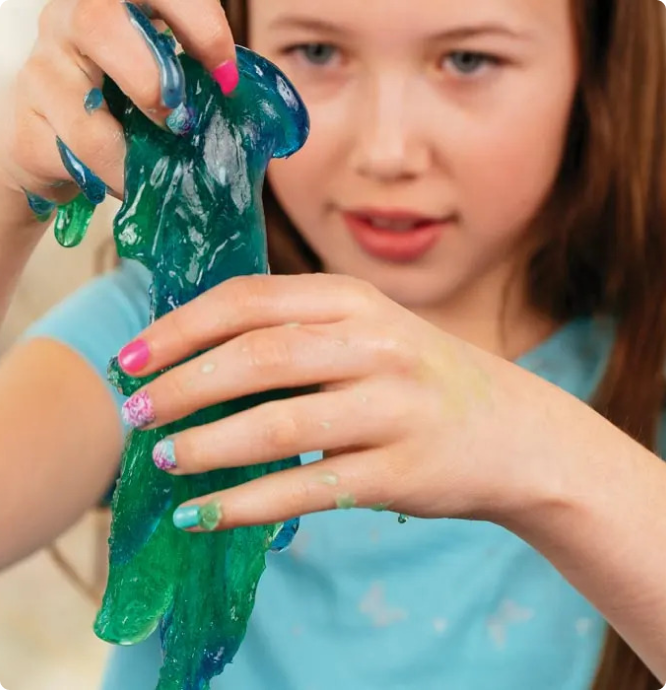
How to Make Slime
popular DIY slime recipes
Did you know you can make your own slime or "goop" for a fun learning and play activity? Non-Newtonian liquids are fascinating for all ages and provide a great learning opportunity about chemistry.
jump to recipe
Find four popular DIY slime recipes below! With these easy-to-do homemade slime recipes, kids can learn about valuable scientific principles while they create, play with, and explore four different kinds of slime. Scroll to discover how to make slime with borax, how to make slime without borax, how to make slime with glue, how to make slime without glue, and more!
The first easy slime recipe listed below will show you how to make slime with glue and how to make slime with borax. The second easy slime recipe is called "Super Slime," and it will teach you how to make slime with borax but without glue. Finally, the Glooze and Oobleck slime recipes reveal how to make slime without borax AND without glue; instead, they use household ingredients, like skim milk and cornstarch, to transform into amazing, ooey-gooey substances. Whether you're looking for a slime recipe without borax or with it, a slime recipe with skim milk, or a slime recipe with cornstarch, we've got options for you!
Our hands-on Slime Recipe Kit for Kids is complete with all the slime ingredients you need - including lab-quality chemicals, containers, and instructions for making the first two types of slime listed below - Simple Slime (putty-like texture) and Super Slime (clear & gooey). To make Glooze (slimy & ooze-like) and Oobleck (resembles quicksand), simply add kitchen staples, like corn starch, skim milk, vinegar, and baking soda!
Start your slime science experiment at home today!
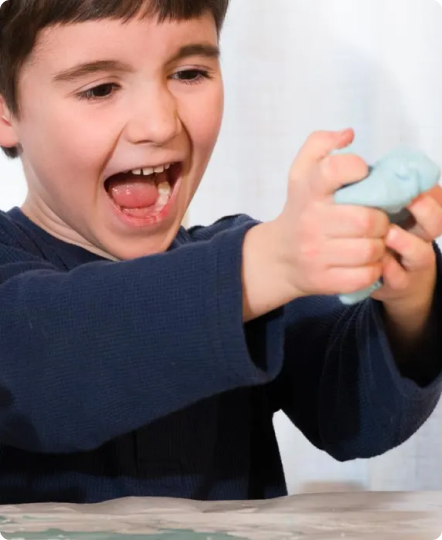
diy slime recipe
Simple and Easy Slime Recipe
This version of slime (also called Gak and Glue Slime) shows you how to make slime with glue and Borax. This is a fast & easy slime recipe!
How to Make Simple Slime
- Pour ½ cup of the polyvinyl alcohol (PVA) solution into a beaker, jar, or bowl. If you want colored slime, add food coloring to the PVA solution and stir with a stir stick.
- Add 2 teaspoons of the Sodium Tetraborate (Borax) Solution into the PVA solution and stir slowly.
- Try lifting some of the solutions with the stir stick and note what happens. Once the slime has formed, you can play with it. Just don't eat it!
- Your slime will last longer if you seal it in a plastic bag and keep it in the fridge, otherwise it will dry out or mold.
What Happened to the Simple Slime?
Polyvinyl alcohol (PVA) is a liquid polymer and is therefore formed from long chains of connected molecules. The sodium tetraborate forms hydrogen bonds with oxygen present in the PVA chains. Hydrogen bonds occur when the positive charge of the hydrogen atoms attracts the negative charge of the oxygen atoms within the compound. The hydrogen bonds link the individual PVA strands to each other, creating a "blob" of slime. Since hydrogen bonds are weak, they will break and reform as you hold the slime or let it ooze onto a flat surface.

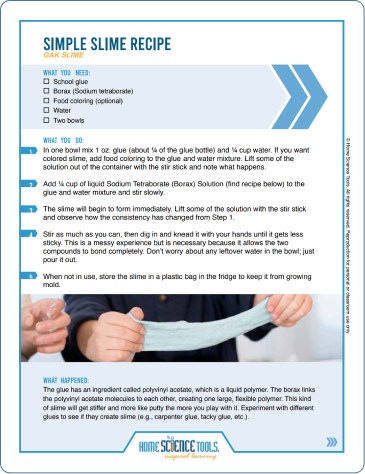

diy slime recipe
Super Slime Recipe
This version of slime (also called Gak and Glue Slime) shows you how to make slime with glue and Borax. This is a fast & easy slime recipe!
The second type of slime is the same clear gooey kind that you see in the movies. This is the real gooey deal! (This slime is non-toxic, but still, keep these slime ingredients away from unsupervised children and wash your hands after playing with the slime.)
How to Make Super Slime
- Pour ½ cup of the polyvinyl alcohol (PVA) solution into a beaker, jar, or bowl. If you want colored slime, add food coloring to the PVA solution and stir with a stir stick.
- Add 2 teaspoons of the Sodium Tetraborate (Borax) Solution into the PVA solution and stir slowly.
- Try lifting some of the solutions with the stir stick and note what happens. Once the slime has formed, you can play with it. Just don't eat it!
- Your slime will last longer if you seal it in a plastic bag and keep it in the fridge, otherwise it will dry out or mold.
What Happened to the Super Slime?
Polyvinyl alcohol (PVA) is a liquid polymer and is therefore formed from long chains of connected molecules. The sodium tetraborate forms hydrogen bonds with oxygen present in the PVA chains. Hydrogen bonds occur when the positive charge of the hydrogen atoms attracts the negative charge of the oxygen atoms within the compound. The hydrogen bonds link the individual PVA strands to each other, creating a "blob" of slime. Since hydrogen bonds are weak, they will break and reform as you hold the slime or let it ooze onto a flat surface.

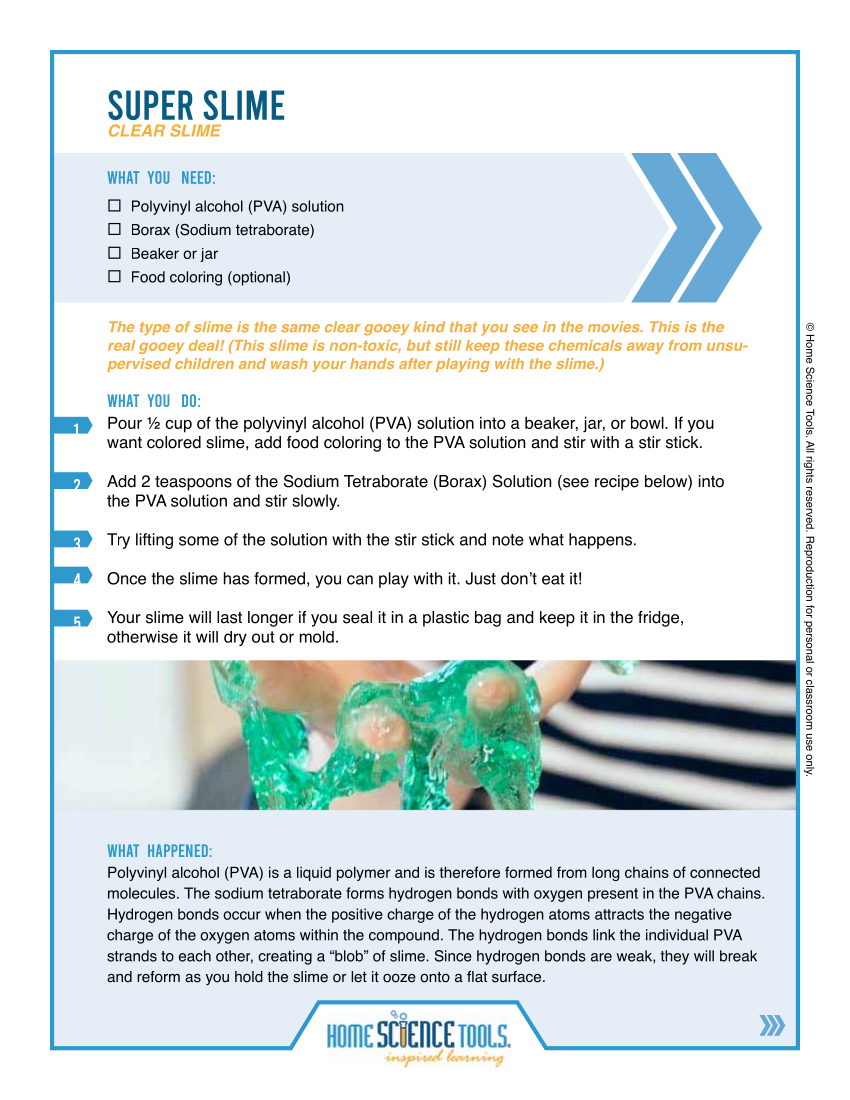

diy slime recipe
Glooze Slime Recipe
If you're wondering how to make slime without borax, this Glooze slime recipe is an excellent option. This slimy substance is made from skim milk, vinegar & baking soda!
What You Need to Make Glooze Slime
- Skim milk
- Vinegar
- Baking soda
- A coffee filter
The second type of slime is the same clear gooey kind that you see in the movies. This is the real gooey deal! (This slime is non-toxic, but still, keep these slime ingredients away from unsupervised children and wash your hands after playing with the slime.)
How to Make Glooze Slime
- Add 7 tablespoons of skim milk to a cup and add 1 tablespoon of vinegar to the milk. Gently stir the mixture until solids have formed.
- Let the solids sink to the bottom of the mixture and then drain off the liquid using a filter (a coffee filter works best). Let the solids drain for a few minutes.
- Add ¼ teaspoon of baking soda to the solids and knead together to form a slimy mixture from milk.
What Happened to the Glooze Slime?
When you added the vinegar to the milk, it caused the milk's protein, casein, which is also a polymer, to separate from the liquid part of the milk and clump together to form solids. Casein is used in adhesives, paints, and even plastics. The baking soda neutralizes the acid added, which allows the casein to go back to its liquid form.


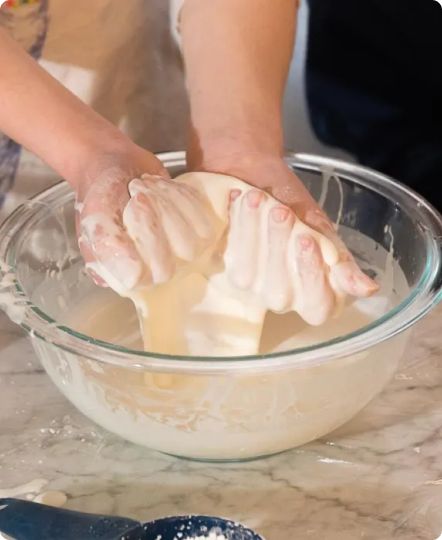
diy slime recipe
Oobleck Slime Recipe
This is another slime recipe without borax or glue. Make a non-Newtonian fluid that resembles quicksand using cornstarch.
What You Need to Make Oobleck
- Cornstarch
- Water
- A big bowl
The second type of slime is the same clear gooey kind that you see in the movies. This is the real gooey deal! (This slime is non-toxic, but still, keep these slime ingredients away from unsupervised children and wash your hands after playing with the slime.)
How to Make Oobleck Slime
- In the plastic mixing bowl, combine small amounts of water and cornstarch together to form a mixture that looks like heavy whipping cream and has the consistency of honey. The approximate ratio of the cornstarch to water mixture is 2 cups of cornstarch to 1 cup of water. So if you use all of a regular-sized box of cornstarch (about 16 oz.), you will use about 1½ cups of water. It is best to start with less water and slowly add it until the desired consistency is reached.
- After making your mixture, gently lay your hand on the surface of the cornstarch-water mixture. You should notice that your hand sinks in the mixture like you would expect it to do. Move your hand through the mixture, slowly first and then trying to move it really fast. Was it easier to move your hand slowly or quickly through it?
- If your mixture is deep enough to submerge your entire hand in it, try grabbing a handful of the mixture and pulling your hand out quickly. Then try again, this time relaxing your hand and pulling it out slowly. Did you notice a difference?
- Try punching the cornstarch-water mixture. (Be careful not to hurt yourself on the bowl!) Make sure to hit the substance hard and pull your fist back quickly. Did the substance splatter everywhere or did it remain in the bowl? (If it splattered, add more cornstarch.)
- Whenever you gently and slowly move your hand through the cornstarch-water mixture, it behaves like a liquid. But when you try to move your hand through it quickly or forcefully hit the substance, it behaves like a solid. This cornstarch-water mixture behaves similarly to quicksand.
What Happened to the Oobleck?
The flow and movement of fluid are affected by its viscosity, or how sticky and thick it is. Quicksand and the cornstarch-water mixture are both non-Newtonian fluids. Non-Newtonian viscosity changes with the type of force applied to it. The viscosity of Newtonian fluids (such as water and honey, which follow Sir Isaac Newton's law of viscosity) is dependent only on the temperature and pressure of the fluid, not the force applied to it. For instance, warm honey (less viscous) flows much more freely than cold honey (more viscous).
Since the ability of a non-Newtonian fluid to move depends on the force or stress applied to it, these fluids do not act like ones we are more familiar with (e.g., honey or water). A light pressure, such as pouring or gently pressing the cornstarch-water mixture, allows it to move like a liquid.


Explore more of our most popular science projects!
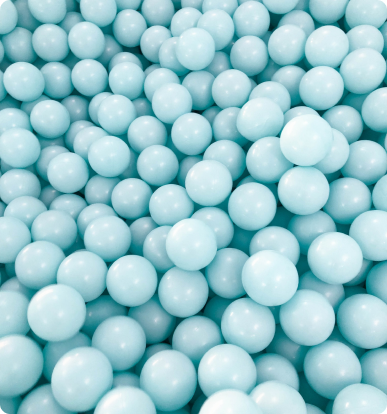

We get it. Science can be messy. But Home Science Tools' products and service can handle it.
Our products are durable, reliable, and affordable to take you from the field to the lab to the kitchen. They won't let you down, no matter what they're up against. Whether it's (over)eager young scientists year after year, or rigorous requirements that come once-in-a lifetime.
And if your science inquiry doesn't go as expected, you can expect our customer service team to help. Count on friendly voices at the other end of the phone and expert advice in your inbox. They're not happy until you are.
Bottom line? We guarantee our products and service won't mess up your science study—no matter how messy it gets.
Questions? Get in touch with our Customer Service team.
Source: https://www.homesciencetools.com/article/how-to-make-slime/
0 Response to "How to Make Slime With Glue Easy Steps"
Post a Comment